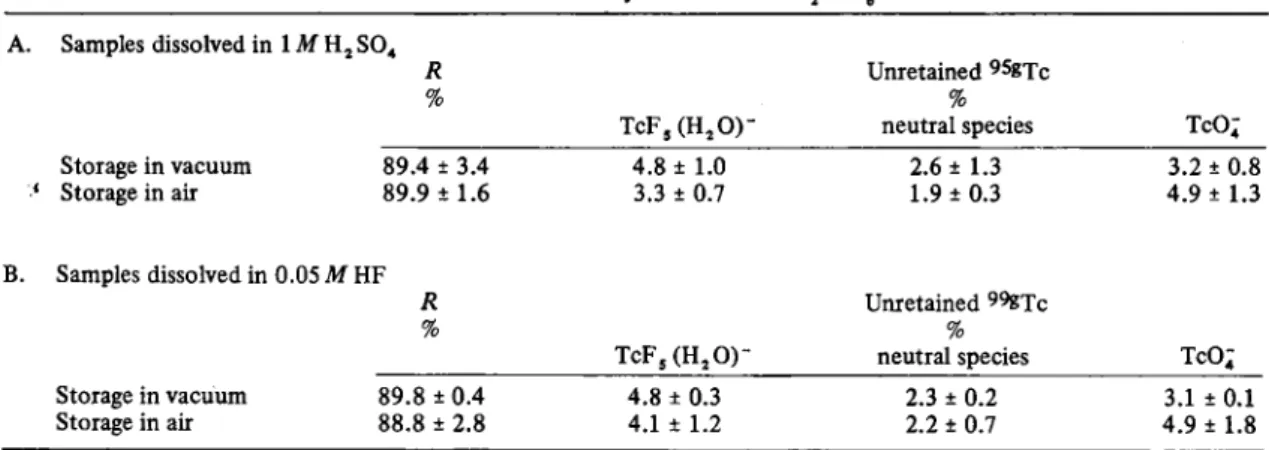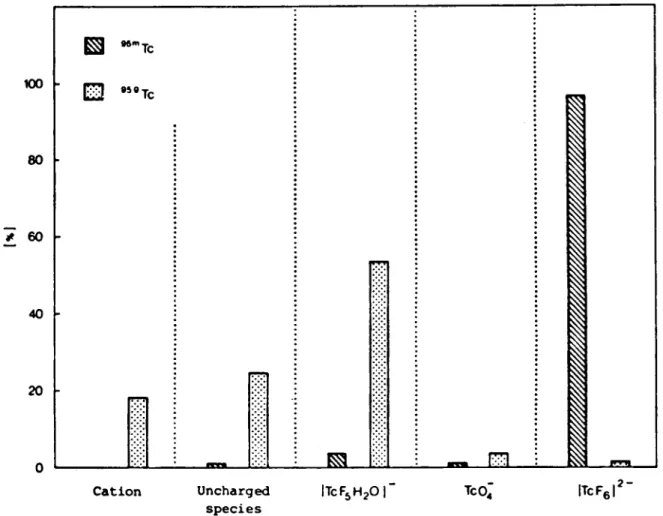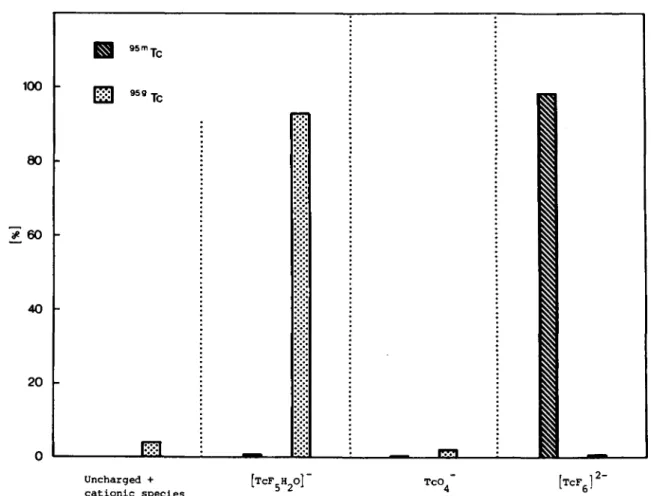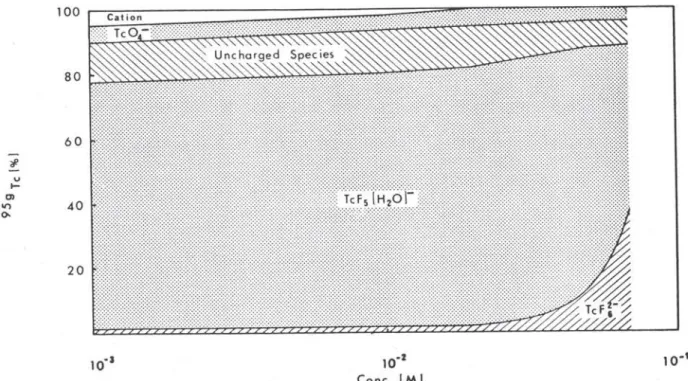Radiochimica Acta 31, 7 9 - 84 (1982)
© Akademische Verlagsgesellschaft, Wiesbaden 1982
Chemical Effects of I.T. of Tc in a iVljTcFg Solid Matrix and in Solutions
By E. lANOVlCl, P. LERCH, G. ZAHNER, Institut d'Electrochimie et de Radiochimie, Ecole Polytechnique Federale Lausanne, Switzerland
and A . G. MADDOCK, University Chemical Laboratory, Cambridge, England
(Received November 30, 1981 ;revised March 2 4 , 1 9 8 2 )
Hexafluorotechnetate (IV) / ^^•"Tc / jlsomeric transition
Summaiy
The chemical effects of the I.T. of ^Smjc have been studied in MjTcF, in the solid matrix and in solutions. The retention of 95gTc for the solid matrix was found to be about 90%. The un-retained 'Sgjc appears as TcF, (HjO)", neutral and TcO; species. At low concentration (10"' - 1 0 " ^ M) of K , T c F , in HF, HjSO, and H, O solutions the retention was found to be about 1 %. The unretained ^^iJc was found preponderately as TcF, ( H , 0 ) ' : 90% in HF, 80% in H , 0 and 50% in HjSO<. An effect of tem-perature on the unretained ^^KTc distribution in sulfuric acid was observed. At higher concentration of KjTcF, in Solution, the retention increases at the expense of TcF^ (H^O)" and uncharged species. A comparison with previously obtained results on the K,TcCl, is made.
Introduction
The chemical effects of I.T. of in ammonium and potassium hexachlorotechnetate have been studied both in solutions and solid matrices [1,2], The retention of
in Solution was found to be dose to zero. The un-retained appeared preponderantly as hydrated TCO2 and cationic species, as T e d s (HiO)" and as TcOi. In solid matrices the retention was found to be higher than 70%.
It is possible that the ligand halogen has an effect on the chemical behaviour of the so the study of the ^^'"Tc decay has been extended to K j T c F e , both in Solu-tion and solid form. The use of soluSolu-tions of Ag2 TcFg enables one to explore the effect of scavenging some of the Auger cascade electrons. It must be noted that the I.T. in ammonium and potassium-halotellurates(IV) does not lead to any change in the chemical state of the Tc-ground State [3].
Experimental
P r e p a r a t i o n of labelled C o m p o u n d s
The ' ^ ' " T c was obtained by the Irradiation of molyb-denum powder with 25 MeV protons in the SIN cyclotron at VilUgen, Switzerland. The Mo powder was dissolved in 30% H2O2 using a reflux system and '^'"Tc was separated as TcOj as previously described [1,4].
The Ki^'^^'^^TcFg was prepared by the fusion of With KHF2 following the method of
S C H W O C H A U and H E R R [ 5 , 6 ] . After 2 0 minutes fusion in a platinum crucible the cooled melt was dissolved in water and the much less soluble K2TCF6 separated from the more soluble potassium halides. The Solution contain-ing K2 TcFs was evaporated at room temperature. The identity of the pale pink crystals was confirmed by their X ray powder diffraction pattem [7]. The UV/visible spectrum of the Solution of the K2 TcFg agreed with pub-lished data [8].
The solutions of Ag2"('®'">TcF6 used were prepared by mixing appropriate amounts of solutions of
and AgNOj. The solutions therefore also contain K"^ and NO3 ions. The resulting Solution was filtered and the Tc content determined spectrophotomet^ rically after oxidation of the TcFg to TcO^.
S e p a r a t i o n p r o c e d u r e
For the Separation of the different technetium species low voltage electrophoresis was used. The paper strips used were Schleicher-Schuell No 2043 B. A voltage of 400 F was applied for 110 min. The supporting electrolyte was H2SO4 1 M and HF 0.1 M. The paper was cut into small pieces before the activity was measured.
Results
Like K2ReF6 the K2TCF6 is much more resistant to hy-drolysis than the corresponding chloro Compound. Elec-trophoretic measurements on our materials showed tiny amounts of TcFj H2O", an uncharged species and TcO^ ( < 2.5%). These amounts do not change with the age of the Solution after 30 minutes and up to 10 days. This may be due to small amounts of impurities in the initial K j TcFs or, perhaps more likely, a limited amount of hy-drolysis upon Solution.
The mobility ratio of the new anionic species to the T c F | " (0.41 ± 0.05) is very similar to the mobility ratio of TcCl; (H2 0 ) " and TcCl? By analogy with TcCI« " it can be assumed that the first Step in TcFi ~ hydrolysis pro-duces the TcFs (H2 O)" species. Further aquation will lead to TCF4 (H2 0)2 or/and TCO2 x H2O and TcFj (H2 0)5. The ~ 1 % of TCO4 probably results from the oxidation of one or more of these species.
The extent of hydrolysis for the same concentration of T c F | - (10"^ M) is much less important in 0.05M HF than in water or in 1M H2 SO4.
80 E. lANOVICI, P. LERCH, G. ZAHNER and A. G. MADDOCK
Table I.Distribution of «SgXc in solid K , T c F , A. Samples dissolved in 1 Af H , SO4
R Unretained 9SBTc
fo
T c F , ( H , 0 )
-70
neutral species TcO; Storage in vacuum 89.4 ± 3.4 ' Storage in air 89.9 ± 1.6 4.8 ± 1.0 3.3 ± 0.7 2.6 ± 1.3 1.9 ± 0.3 3.2 ± 0.8 4.9 ± 1.3 B. Samples dissolved in 0.05 M HF R Unretained ^ ^ T c /o T C F 5 ( H , 0 ) -/o
neutral species TcO; Storage in vacuum 89.8 ± 0.4 Storage in air 88.8 ± 2.8 4.8 ± 0.3 4.1 ± 1.2 2.3 ± 0.2 2.2 ± 0.7 3.1 ± 0.1 4.9 ± 1.8
Table 2. Chemical distribution o / ^ S S T c / o r solutions of hexafluorotechnetates*
Storage conditions 9S8Tc distribution
Salt Conc. Ambient T, T c F J - T c F , ( H , 0 ) -% Cationic Uncharged % TcO; used (M) atmosph. K (R) % T c F , ( H , 0 ) -% % Uncharged % % A. Solutions in sulphuric acid K , TCF. 1 0 - ' N , 276 1.2 ± 1.0 80.9 ± 0.5 12.0 ± 1.5 5.9 ± 1.4 K , Tc F . 1 0 - ' N , 276 2.3 ± 2.8 81.1 ± 1.7 10.1 ± 2.6 6.5 ± 2.4 K , T c F . 1 0 - ' N , 283 1.3 ± 0.5 54.7 ± 3.6 16.7 ± 2.1 24.2 ± 1.0 3.1 ± 0.9 K , T c F . 1 0 - ' N , 283 34.6 ± 4.1 27.1 ± 2.5 2.5 ± 3.7 30.7 ± 4.5 5.1 ± 0.8 K , T c F . 1 0 - ' air 276 1.2 ± 0.6 81.3 ± 0.6 14.1 ± 1.1 3.4 ± 1.2 A g , T c F , 1 0 - ' N , 276 1.7 ± 1.6 85.5 ± 3.1 2.4 ± 2.1 8.8 ± 3.3 1.6 ± 1.9 B. Solutions in hydrofluoric acid K j T c F , 1 0 - ' N , 283 0.3 ± 0.4 93.1 ± 1.6 4.2 ± 2.1 2.4 ± 0.9 K j T c F j 5 • 1 0 - ' N , 283 36.6 ± 2.6 52.4 ± 3.3 3.1 ± 1.0 4.8 ± 0.9 3.1 ± 0.8
AU data are mean values of at least 4 determinations.
Table 3. Chemical distribution o / ' S g X c m K^TcF^, water Solution. Storage temp.: 283 K.
Conditions 958Tc distribution
Ambient Salt conc. T c F ' -
TcFäCHjO)-%
Cationic Uncharged TcO;
atmosph. iM) ( Ä ) % TcFäCHjO)-% % % % N , 1 0 - ' 1.6 ± 1.0 76.4 ± 0.8 3.9 ± 1 . 1 12.8 ± 2 . 4 5.3 ± 1.6 N , 1 0 - ' 2.4 ± 1.0 78.2 ± 2.8 2.2 ± 1 . 0 12.4 ± 1 . 6 4.8 ± 1.2 N , 2 - 1 0 - ' 1.7 ± 1.9 80.0 ± 2.0 12.9 ± 2.2 5.4 ± 1.1 N , 2 - 1 0 - ' * 2.7 ± 0.6 76.0 ± 0.5 4.3 ± 0.2 12.1 ± 1.0 4.9 ± 1.0 N , 0 1 0 - ' 2.7 ± 2.3 79.6 ± 2 . 5 13.5 ± 1 . 3 4 . 2 + 1.1 ' Storage temperature: 293 K.
Chemical Effects of LT. of ^^mj^. a M , T c F , SoUd Matrix and in Solutions 81
In Table 1 are presented the results for a K2 TcFe ma-trix for different storage and dissolution conditions. There is no dependence of retained on either the ambient atmosphere (vacuum or air) or on the temperature. The R value is about 90% independently of how the sample dis-solution was done, in the presence or absence of Tc(IV) carrier.
The unretained appears largely as TcF; (H2 0)~ and TcOj. There is some suggestion that the presence of air leads to more ^^btcO^ and less ^^«TcFs (H^0)". Al-though the amounts of each product species are small they are always a factor or two greater than the amounts of
found as the same species due to hydrolysis, or perhaps impurities in the initial K2TCF6. In addition, Solu-tion in 0.05 M HF gives very much the same proporSolu-tions of separable products but the amount of ^^'"Tc in these species is substantially reduced. The near identity of the results following Solution in 1M H j SO4 and 0.05 M HF indicate that no appreciable reversal of the aquation of the products takes place.
It is interesting to compare the results obtained for solid KiTcFg with those for the Solution.
Table 2 shows the distribution of in 1 Af H j SO4 and 0 . 0 5 M H F solutions which were 10"^ and 10"^ M i n K j TcFfi and Ag2 TcF«. They were kept at 276 K under nitrogen or air. The retention of is about 1 %. In sul-phuric Solution, the unretained is found
preponder-antly (80%) as TcFj (H2O)", about 12% as uncharged, including only traces of cationic, species and about 6% as TcOi. The corresponding fraction for Ag2TcF6 represents only 1 %. In hydrofluoric acid at a low concentration of K2 TcFg the retention is very small, the TcF; (Hj 0 ) " frac-tion increases to 93% and uncharged species and TcO^ are much less important than in sulphuric acid, 4% and 2% respectively.
At 283 K for lO-^Tl/KiTcFg in sulphuric Solution the retention remains at about 1 % but the distribution of un-retained '^«Tc is changed compared to 276 K. The cation-ic and uncharged species increase to 16% and 24% respec-tively. The TcFs (HjO)" decreases to 54% and the TcOi represents about 3%. It is clear that the further hydrolysis of TcFj (H2O)" is favoured by the increase of temperature. Measurements at 293 K confirm this trend. In simple aque-ous Solution, however, the distribution of the is sub-stantially the same at 2 8 3 - 2 9 3 K for 2 • 10"^ and 5 • 10"^
M solutions.
Above about 10"^ M the distribution changes with the concentration of hexahalotechnetate. This effect is more important in hydrofluoric acid. In sulphuric acid the reten-tion increases at the expense of the TcFs (H2 0)~ and cationic species. In hydrofluoric acid the increase occurs only at the expense of TcF5(H20)". There are no signifi-cant changes in the proportions of the neutral species and TcOi. K» 80 ^ 60 40 20 ^ •«"'Tc m " ' T C C a t i o n U n c h a r g e d iTcF^HjOl' s p e c i e s TcOj iTcFßl 2
82 E. lANOVICI, P. LERCH, G. Z A H N E R and A . G. M A D D O C K 100 80 # 60 40 20 "Tc 959 Tc
I
Uncharged + cationic specles [TCF.HO]' 5"2 •• ^ " " e ' TcO, [TCF. l 2-Fig. 2. Distribution of T c in different chemical species for 1 0 " ' j W K J T c F , in 0.05iWHF Solution. Storage conditions: 283 K, N ,
100 80 # 60 40 20 "Tc 95 9 To
m
uncharged species[tcF^H^O]' TcO. ITcF, i 2
Chemical Effects of I.T. of ^^"'Tc in aM,TcF, Solid Matrix and in Solutions 83 100 CD lO o. 10- 10 10 Conc. IMI
Fig. 4. Tc distribution for KjTcF, in water as a function of potassium hexafluortechnetate concentration. Storage conditions: 283 K , N ,
- 1
practically constant. At the concentration 5 • 10"^ M, the increase of retention is lower than in hydrofluoric acid, 13% and about 35% respectively. In aqueous Solution at concentrations higher than 7 • 10"^ M the increase of
re-tention is unexpectedly high. The solubility of Ka TcF^ prevents the experiments being extended to higher con-centrations.
In Figs. 1 and 2 are shown the distribution of '^""Tc and in each separated species for 10"^ MKaTcFe
sulphuric and hydrofluoric acids. About 4% of was found as TcFj (H2O)" in sulphuric acid and only 0.5% in hydrofluoric acid. appears exclusively as TcF; (Hj 0 ) ' in HF Solution and as TcFs (H2O)", uncharged and cation-ic species in H2SO4 Solution. 2 - 3 % of is found in both acids.
The relative high stability of the TcFg " ion allowed experiments on the '^'"Tc decay in water. Results are presented in Table 3. In solutions at concentrations of
10"^ and 10"^ M the retention of'^«Tc is about 1%. The 1 • The solid K j TcFg distribution of unretained as neutral and cationic
species, TcF5(H2 0 ) " and TCO4 is not very different from that found in sulphuric Solution at 276 K (Table 2). No changes occur in solutions saturated with N2 O. In aqueous
Solution the cationic fraction decreases with increasing con- than with the TcCli " salts. But the results can still be ex-Discussion
The much greater resistance of TcFi " to hydrolysis facili-tates the study and the Interpretation of the effects of the isomeric transition. A rather clearer picture is obtained centration; at 2 • 10"^ M this fraction practically
disap-pears, while an increase in the yield of TcFs (HjO)" is ob-served. A comparison of results in water and sulphuric acid at 283 K in the concentration ränge producing low retentions (~1 %) shows that the proportion of
'^^TcFs (H2O)" is larger in water. These results show a higher stability of this complex in water than in sulphuric acid Solution.
In Fig. 3 is shown the distribution of ^^'"Tc and '^«Tc in each separated species for 10"^ A/KjtcFe in water. A higher proportion of ^^'"Tc as TcOJ in water than in HF and H2SO4 solutions is found (Figs. 1, 2, 3). As in HF Solution, less than 0.5% of'®'"TcF5(H20)" is found.
An increase of hexafluorotechnetate concentration in water produces an increase of retention (Fig. 4). In solu-tions of concentration higher than 2 • 10"^iV/the increase of retention occurs at the expense of the uncharged and TcFs (Hz 0 ) " species, the proportion of TcO^ remaining
plained in terms of the formation of TcXs and smaller amounts of TCX4 and TcX^ in the lattice.
In this, and in the previous study on solid TcCli " salts, it appears that the Auger cascade seldom, if ever, leads to a long-lived oxidation of the technetium. The small a-mount of found may well arise from the oxida-tion known to accompany aquaoxida-tion-hydrolysis.
The retention in KjTcFö is greater than in KaTcClg. Both the more compact lattice of the former salt and/or the stronger T c - F (3.06 eV) than Tc-Cl (1.51 eV) bond energy may be concerned.
2. Behaviour of solutions
As in TcCle " solutions practically every I.T. event frag-ments the TcF« Most of the events appear to produce a TcFs, ä smaller, but still substantial, proportion yields
84 E. lANOVICI, P. LERCH, G. ZAHNER and A. G. MADDOCK
TcF4 and possibly a little gives T c F s . These fragments undergo aquation, or in the presence of other ligands, such as F " , some anation. As previous studies have shown these processes may be accompanied by a small amount of oxidation, by air or water, to give TcO^.
Perhaps the most interesting result is the large effect of the concentration of TcFg on the distribution of the This could arise from a reaction such as
TcFs- + T c F i - ^ | F 5 T c F T c F s |3- . * T c F i - + T c F s
However, in its simplest form this would suggest a depence on the first power of the TcFe concentration and the data suggests more nearly a depence on the cube. This may be explained* if the above reaction only occurs if the TcFg is within a certain distance of the nascent ^®®TcFs. A more detailed study of the concentration dependence will be required before one can commit one-self on this point.
Scavenging of Auger and secondary electrons by dis-solyed nitrous oxide had little effect on the distribution and the only difference in the Ag^TcFg Solution seemed to be a reduction in the amount of formed.
We thank a referer for drawing our attention to this interpreta-tion.
3. G e n e r a l c o n c l u s i o n s
The combined results seem to suggest that the energy available for bond rupture following the isomeric transi-tion is not extremely large compared to bond energies. This would indicate the process is not one of "Coulombic explosion" but is associated with the energy released in the numerous electron capture events that rapidly follow the Auger charging due to internally converted isomeric transi-tion in the Condensed phase.
Refeiences
1. lANOVICI, E., LERCH, P., PROSO, Z., DECOMBAZ, M., MADDOCK, A. G.: RadiocMm. Acta 26, 141 (1979). 2. lANOVICI, E., LERCH, P., ZAHNER, G., MADDOCK, A. G.:
Radiochim. Acta 28, 23 (1981).
3. AMBE, S., SAITO, N.: Radioisotopes 21, 17 (1972).
4. lANOVICI, E., LERCH, P., ZAHNER, G., MADDOCK, A. G.: Radiochim. Acta 29, 79 (1981).
5. SCHWOCHAU, K., HERR, W.: Angew. Chem. 75, 95 (1963). 6. WEISE, E.: Z. Anorg. Allg. Chem. 283, 277 (1956). 7. PASCAL, P.: Complements au nouveau traite de chimie
mine-rale. Technetium,Rhenium. Masson, Paris, 10, 62 (1978). 8. J?)RGENSEN, CHR. K., SCHWOCHAU, K.: Z. Näturforsch.



